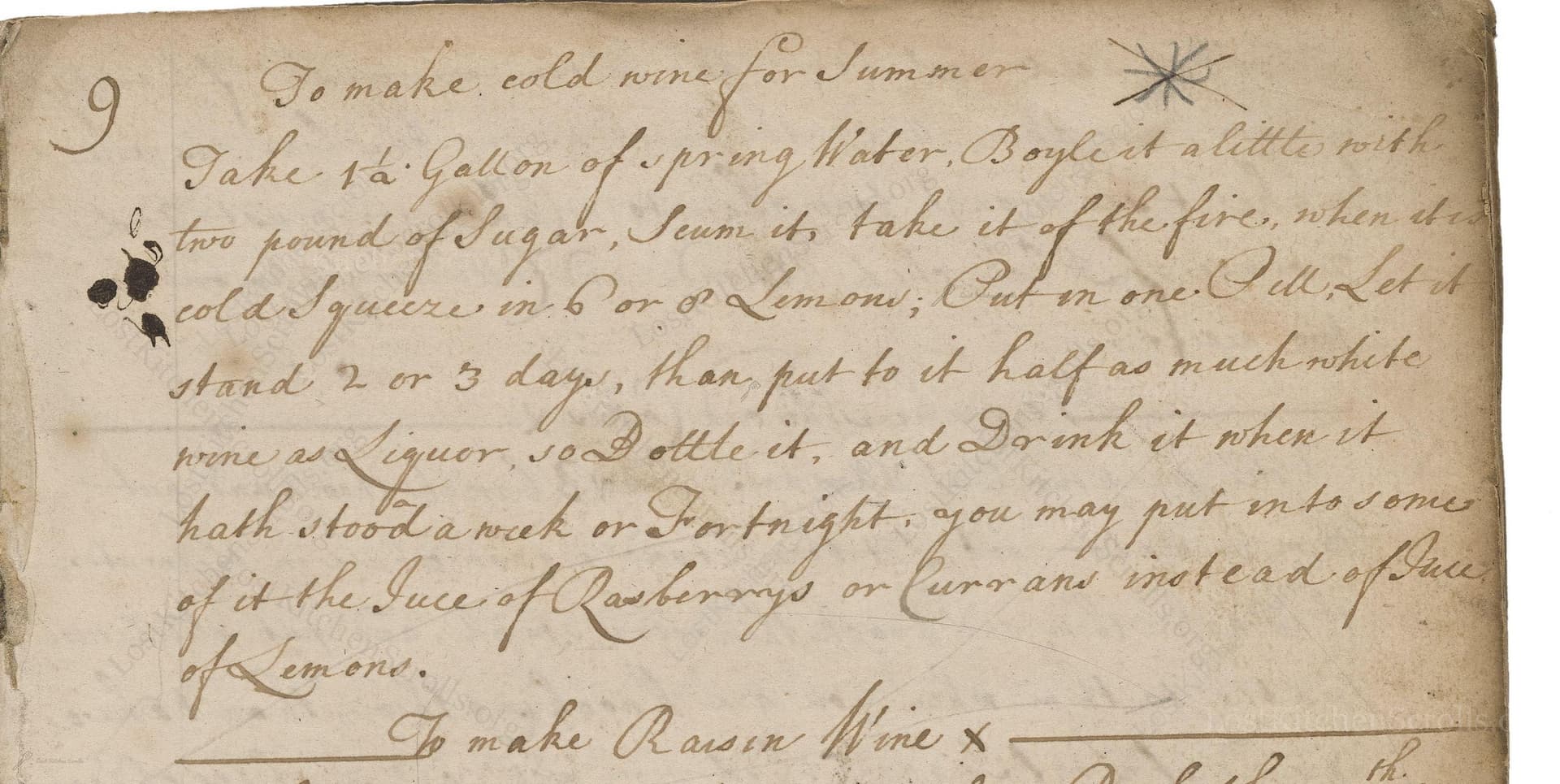To Make Cold Wine For Summer
From the treasured pages of Receipt book of Dorothy Stone
Written by Dorothy Stone

To Make Cold Wine For Summer
"Take 1/4 Gallon of Spring Water, Boyle it a little with two pound of Sugar, Scum it; take it of the fire, when it is cold Squeeze in 6 or 8 Lemons; Put in one Gall: Let it stand 2 or 3 days, than put to it half as much white wine as Liquar, so Bottle it, and Drink it when it hath stood a week or fortnight; you may put into some of it the Juice of Rasberrys or Currans instead of Juice of Lemons."
Note on the Original Text
The recipe is written in the direct, conversational improvised style typical of early 18th-century manuscripts—expect imprecise measurements and instructions like 'take it off the fire' and 'put to it half as much wine as Liquar.' Spelling reflects early modern English conventions: 'Boyle' for 'boil', 'Scum' as a verb for skimming, 'Liquar' for 'liquor' (the sweetened, flavored base). Instructions are compact yet rely on the reader's kitchen know-how and a degree of intuitive judgment, which was common for household recipe books of the era.

Title
Receipt book of Dorothy Stone (1725)
You can also click the book image above to peruse the original tome
Writer
Dorothy Stone
Era
1725
Publisher
Unknown
Background
Step into the delicious world of early 18th-century kitchens with Dorothy Stone, where classic recipes and culinary curiosities await. Expect a charming medley of hearty fare, sweet treats, and the tasteful secrets of a bygone era.
Kindly made available by
Folger Shakespeare Library
This summery 'cold wine' recipe comes from Dorothy Stone, active around 1725, at a time when homemade, fruit-based punches and cordials were all the rage among the British gentry. Recipes like this would have served as both a cooling refreshment and a display of hospitality at garden gatherings. Lemons and sugar were still luxury items, signifying a certain social status, while the combination with white wine created a proto-sangria or lemonade-wine hybrid enjoyed long before commercial soft drinks had arrived. The flexibility to use local fruits like currants or raspberries reflects the resourcefulness of 18th-century cooks and the desire to take advantage of seasonal abundance.

Historically, this recipe would have required a large copper or iron pan for boiling water and sugar, a wooden spoon for stirring, linen cloths for straining and skimming, and stoneware jars or glass demijohns for maceration and storage. Lemons would be squeezed by hand, and the final beverage would be decanted into corked glass bottles, which were stored in cool cellars or ice-houses to mature.
Prep Time
20 mins
Cook Time
10 mins
Servings
24
We've done our best to adapt this historical recipe for modern kitchens, but some details may still need refinement. We warmly welcome feedback from fellow cooks and culinary historians — your insights support the entire community!
Ingredients
- 1 quart spring water
- 2 pounds white granulated sugar
- Juice of 6–8 lemons (or substitute with raspberry or red currant juice for variation)
- 7 quarts dry white wine (divided: 5 quarts first, then 2 quarts)
Instructions
- Begin by boiling 1 quart of fresh spring water with 2 pounds of white granulated sugar.
- Skim off any foam that rises to the surface.
- Remove from heat and allow to cool completely.
- Once cooled, squeeze in the juice of 6 to 8 fresh lemons, straining out any seeds or pulp for clarity.
- Add 1 gallon plus 1 pint (5 quarts) of good quality white wine and stir well.
- Allow this mixture to stand for 2 to 3 days in a cool place, covered but not sealed completely.
- After this period, add an additional 2 quarts of white wine (for a total of 1.75 gallons or 7 quarts).
- Bottle the mixture tightly and let it mature in a cool, dark place for at least 1 to 2 weeks before drinking.
- For a variation, replace the lemon juice partly or entirely with fresh raspberry or currant juice for a delightfully fruity version.
Estimated Calories
230 per serving
Cooking Estimates
You will spend time boiling water and sugar, letting the mixture cool, and juicing the lemons. After that, you combine everything and let it sit. Most of the waiting time is for the mixture to develop its flavors. The calorie count is based on a standard wine-based punch serving.
As noted above, we have made our best effort to translate and adapt this historical recipe for modern kitchens, taking into account ingredients nowadays, cooking techniques, measurements, and so on. However, historical recipes often contain assumptions that require interpretation.
We'd love for anyone to help improve these adaptations. Community contributions are highly welcome. If you have suggestions, corrections, or cooking tips based on your experience with this recipe, please share them below.
Join the Discussion
Rate This Recipe
Dietary Preference
Main Ingredients
Culinary Technique
Occasions

Den Bockfisch In Einer Fleisch Suppen Zu Kochen
This recipe hails from a German manuscript cookbook compiled in 1696, a time whe...

Die Grieß Nudlen Zumachen
This recipe comes from a rather mysterious manuscript cookbook, penned anonymous...

Ein Boudain
This recipe comes from an anonymous German-language manuscript cookbook from 169...

Ein Gesaltzen Citroni
This recipe, dating from 1696, comes from an extensive anonymous German cookbook...
Browse our complete collection of time-honored recipes



